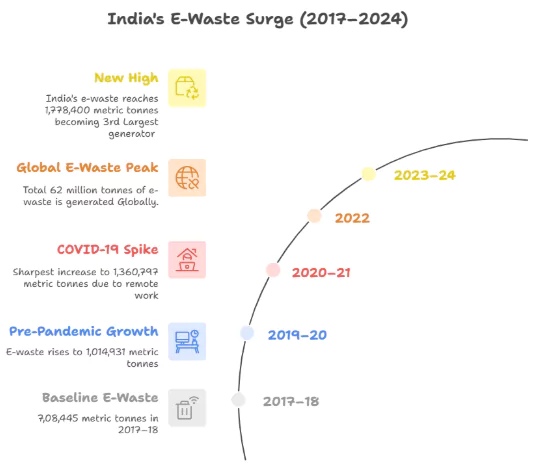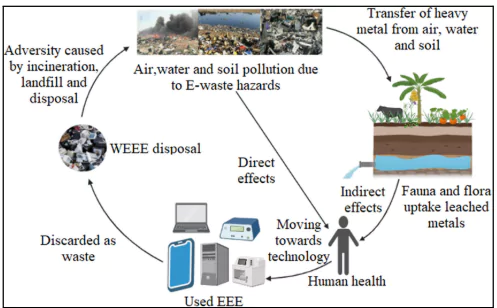India’s e-waste volumes soared by 151.03% in six years , prompting urgent regulatory and systemic reforms.
Status of E-Waste Generation

- India has emerged as the world’s third-largest generator of e-waste after China and the USA.
- Rapid Growth: India witnessed a surge in e-waste from 7,08,445 metric tonnes in 2017–18 to 17,78,400 metric tonnes in 2023–24, with an annual increment of 1,69,283 metric tonnes.
- Biggest Contributors in India: Urban areas and bulk consumers such as schools and government offices significantly contribute to the rising volume, as mandated in the E-Waste (Management) Rules, 2022.
- COVID-19’s Role: The sharpest spike occurred between 2019–20 and 2020–21, driven by increased electronic consumption for remote work and education during the pandemic.
- Global Burden: E- Waste accounts for 70% of toxic waste generated, despite only accounting for around 2% of the total trash humans generate.
- In 2022, the world generated 62 million tonnes of e-waste; only 22.3% was formally recycled.
About E-Waste and Its Impact
- E-waste includes discarded electrical and electronic equipment (EEE) like mobile phones, laptops, refrigerators, and medical devices.
- It contains valuable metals such as Gold, silver , and toxic substances such as plastic, heavy metal, etc.
Impact of Improper Disposal

- Environmental: Informal recycling methods release up to 1,000 toxic chemicals into the environment, including lead, mercury, arsenic, cadmium, and persistent organic pollutants.
- Health Hazards: Exposure to these substances can cause severe health issues, particularly among children and pregnant women.
- As per ILO,Informal e-waste recycling is classified among the worst forms of child labour.
- E-waste Health Risks include:
- Neurodevelopmental disorders
- Respiratory problems and asthma
- Stillbirths and premature births
- Economic Loss: Mismanagement of e-Waste leads to heavy Socio-economic burden in India.
- $10 billion/year in environmental damage (polluted air, water, soil)
- $20 billion/year in social loss from health impacts.
- ₹80,000 crore/year in lost critical metal value due to crude extraction
- $20 billion/year in tax loss due to unregistered, cash-based operations
Methods to Process E-Waste
| Method |
Mechanism |
Concerns/Issues |
| Landfilling |
E-waste is dumped in lined pits, which are then covered with soil. |
Risk of leaching toxic substances (cadmium, lead, mercury) into soil and groundwater. |
| Acid Bath |
Electronic parts are soaked in strong acids (H₂SO₄, HCl, HNO₃) to extract metals. |
Generates hazardous acid waste; risk of water source contamination. |
| Incineration |
E-waste is burned at high temperatures, reducing volume and generating energy. |
Release of toxic gases such as dioxins, furans, and particulate matter causing air pollution. |
| Recycling |
Valuable components like metals are recovered from dismantled e-waste and reused in manufacturing. |
Safer than other methods if done responsibly; informal sector recycling poses health/environmental risks. |
| Reuse |
Functional or repairable electronics are refurbished and redistributed, often to underprivileged communities. |
Most eco-friendly method; promotes circular economy and extends product life cycle. |
E-Waste Management Rules in India
- E-Waste (Management) Rules, 2022: Came into effect on April 1, 2023, replacing the 2016 Rules.
- Key provisions include:
- Registration of recyclers, refurbishers, and producers
- Mandatory procurement of EPR certificates at a fixed floor price.
- Clear annual recycling targets for producers
- Coverage : It covers 106 categories of electronic and electrical equipment (EEE). Data for the full list started from FY 2023–24; earlier estimates (2019–2023) included only 21 items.
Extended Producer Responsibility (EPR)
EPR assigns producers accountability for the full lifecycle of their products, including end-of-life collection and recycling. It promotes:
- Sustainable product design
- Environmental cost integration
- Reduction of municipal waste burden
Floor Pricing: Floor Pricing under E-Waste (Management) Rules, 2022 refers to the minimum fixed price for Extended Producer Responsibility (EPR) certificates that producers must buy from registered recyclers to comply with their obligations, ensuring fair compensation for formal recyclers and curbing illegal practices.
- Encourages use of advanced, safe technologies
- Stabilizes the EPR market and enhances trust
- Promotes material recovery over landfill disposal
Benefit of Stable Pricing: Predictable pricing incentivizes formal sector investment and transforms e-waste from liability to asset, unlocking its economic potential. |
- Bulk Consumer Obligations: Rule 9 mandates that bulk consumers dispose of e-waste only through registered handlers, improving traceability and compliance.
- E-Waste (Management) Amendment Rules, 2024: Provision for trading EPR certificates as per guidelines issued by the Central Pollution Control Board (CPCB) with its approval.
- The CPCB will set the price range for Extended Producer Responsibility certificates at 100% (maximum) and 30% (minimum) of the environmental compensation for non-compliance.
Other Legal Framework to handle e-waste
Hazardous and Other Wastes (Management and Transboundary Movement) Rules, 2016
- Regulates the generation, handling, storage, and transboundary movement of hazardous and other wastes.
- Ensures safe disposal and mandates authorization for waste handling by stakeholders.
- Prohibits import of waste for dumping and promotes resource recovery.
National Action Plan for Chemical and Waste Management
- It is a plan formulated by CPCB for handling hazardous waste.
- Aligns with India’s commitments under the Stockholm and Rotterdam Conventions.
- Stockholm Convention: Adopted in 2001, it aims to eliminate or restrict the production and use of Persistent Organic Pollutants (POPs)
- Rotterdam Convention: Adopted in 1998, it promotes shared responsibility in the international trade of hazardous chemicals.
- It ensures that countries receive information and give prior informed consent (PIC) before importing such substances
- Aims to strengthen institutional mechanisms and promote sound chemical waste management.
- Encourages capacity building, public awareness, and safe disposal practices across sectors.
Challenges
- Low Formal Recycling Rate: Only 43% of e-waste was processed formally in 2023–24.
- Despite growth in processing there is an overall rise in unprocessed e-Waste from 22% in 2019–20, 57% (990,000 metric tonne).
- Lack of State-Wise Data: The absence of granular, state-level e-waste data hampers targeted policymaking and localised interventions.
- Exclusion of Informal Sector: Authorities have failed to integrate the informal sector, which plays a crucial last-mile role in waste collection.
- Lack of Incentives: India lacks tax credit systems for eco-friendly product design, which could motivate producers to create recyclable and durable devices.
- Producer Pushback on Pricing: Some argue that floor pricing increases product costs impacting adaptation.
- However, experts argue that the societal costs of inaction (pollution, health crises, lost resources) are far greater.
- Informal Workforce: In India, informal recyclers (primarily women and children) handle 95% of e-waste.
- Their average lifespan is under 27 years due to constant toxic exposure.
Global Initiatives to Tackle E-Waste
- Basel Convention (1989) of UNEP
- Objective: Control transboundary movements of hazardous waste, including e-waste.
- Implementation: Legally binding treaty; 190+ parties; national reporting and control procedures
- India is a party to the Basel Convention.
- Ban Amendment (2019 Entry into Force)
- Objective: Prohibits export of hazardous waste from OECD to non-OECD countries.
- Implementation: Now legally binding, it aims to protect developing nations from toxic waste dumping.
- Bamako Convention (1991) of African Union
- Objective: Ban import of hazardous waste into Africa.
- Implementation: Legally binding for African nations; enforces strict import controls.
- Waigani Convention (1995)
- Organization: SPREP (Secretariat of the Pacific Regional Environment Programme).
- Region: South Pacific.
- Objective: Ban import/export of hazardous waste in Pacific Island countries.
|
Way Forward
- Formalisation of Waste Management: India must integrate informal workers into formal channels with training, equipment, and social security to enhance efficiency and safety.
- Tax Incentives for Green Design: Encouraging eco-friendly product innovation through tax rebates or credits can foster a culture of sustainable manufacturing.
- It will encourage electronics manufacturers for designing products with extended lifespans and repairability features
- Enhance Monitoring: Develop robust state-level data collection systems for better policy planning and enforcement.
- Public Awareness: Mass awareness campaigns and school-level programs can promote responsible e-waste disposal and participation in take-back schemes.
- Nokia’s Take-Back Campaign failed in India due to lack of awareness.
- Investment: Increased public-private investment in authorised recycling facilities and e-waste parks can scale up formal sector processing.
- Strict Enforcement: Penalise non-compliant producers, refurbishers, and recyclers to ensure adherence to EPR targets and discourage illegal practices.
- Adopting Global Practices: Benchmark pricing, compliance, and safety standards against leading nations.
- For example, globally, EPR fees are significantly higher, ensuring real impact.
- Right to Repair: It empowers consumers to fix devices, extending product lifespans and reducing premature disposal, thereby curbing e-waste generation.
- The EU’s Right to Repair law (2023) mandates manufacturers to offer spare parts and repair services for up to 10 years.
- Periodic Review: Establish a mechanism to revise rules based on evolving technologies, materials, and global commitments.
Conclusion
India must act decisively to manage rising e-waste. Strong policies, floor pricing, informal sector integration, and global cooperation can transform this crisis into an opportunity for sustainable growth and environmental leadership.
![]() 13 May 2025
13 May 2025



